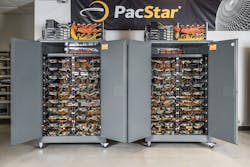Communications networks in the rail transportation industry have seen little change for many years, leading to a host of problems from costly maintenance to lack of flexibility to vulnerability to cyber attacks, along with an inability to efficiently automate operations using positive train control (PTC), communications-based train control (CBTC) and automatic train control (ATC) solutions. Adding to the pressure is the looming federal mandate that regularly scheduled intercity and commuter rail passenger services, as well as main railroad lines, must implement PTC by the end of 2018.
The way forward is advanced IP-based networks based on commercial-off-the-shelf (COTS) technologies that offer greater control and faster communication, and position railroads to take advantage of innovations, such as the Internet of Things (IoT). Such networks offer the potential to dramatically improve capabilities, reliability and flexibility. However, reaping these benefits requires the deployment of networking equipment in challenging environmental conditions.
Any IP-based network requires far more than centralized servers and routers sitting in a secure, air-conditioned office. For rail applications, servers, routers, and other gear must be located trackside, typically in a wayside unit located along a train track right-of-way.
Wayside units, which range in size from a few square feet to 10x10-sized bungalows, represent a worst-case scenario for sensitive network equipment. Environmental challenges are a major factor, as some wayside units are not climate controlled with the temperature in the units varying anywhere from 20 degrees below zero in winter (-28.89 C) to 140 degrees (60 C) in summer. Vibration is another significant consideration. When trains roll past wayside units, the vibration can be significant and can result in equipment malfunction.
Typical high-speed IP network equipment also struggles under "dirty" power conditions that are often prevalent in wayside bungalows and other intermediate signaling locations. This is particularly true for the types of devices designed for offices and rely on conditioned utility-provided power. Equipment used in remote industrial applications must be designed with power supplies that work reliably, and must protect against power spikes and poor-quality power.
Enterprise devices are also not designed to meet highly space-constrained installation locations. Often, industrial IT installations have little available room for additional equipment. For rail and train control networks that require new equipment additions, this can create a requirement to replace wayside IT cabinets.
Military Grade
To solve these issues and enable deployment of enterprise IT equipment where it’s needed, railroads are starting to turn military-grade equipment adapted to meet specific industry needs. For the past 15 to 20 years, the U.S. Department of Defense (DoD) has started adopting rugged, compact and easily transportable IP network technology for use by warfighters in the field and in vehicles.
For these applications, the DoD requires the best available size, weight and power (SWaP), as well as security and ruggedness — making these systems also well-suited for railroad applications. As shown in Figure 1, these small servers and routers are designed with a modular enclosure architecture, so that the modules can be easily transported and then operated right out of their chassis, together with full power conditioning and UPS backup. These systems are significantly smaller than typical network servers intended for rack-mounted deployments.
There are several approaches to ruggedizing technology that the industry has adopted, some involving the use of proprietary network technologies. For most rail applications, the preferred approach is systems that incorporate commercial off-the-shelf (COTS) technology from vendors such as Cisco, Aruba, Haivision, Riverbed, Brocade, and so on — the top makers of secure, interoperable, enterprise-class technology.
The advantage of using enterprise COTS technologies is that railways have already standardized and deployed these technologies into their corporate environments. This means they don’t have to change their existing environment and can take advantage of the wealth of trained experts that they already have in-house. Hardware reliability means fewer repairs and less maintenance, but, perhaps more importantly, it gives rail companies the confidence that safely, securely and reliably deploy modern IP networks.
Solid Chassis
The heart of any rugged module is its chassis. Since rugged equipment must be able to withstand dust, cooling fans are not an option, even though heat is the mortal enemy of electronics. In a fanless environment, efficient heat transfer is vital to ensuring durability. In the best modules — those that have been proven in military operations — the chassis is actually CNC-machined from a solid piece of aluminum and the components are solidly screwed into it. In less expensive alternatives, the chassis is made from cast material, which is weaker and more porous. Consequently, a cast chassis does not transfer heat as effectively and is not as durable as a CNC chassis. In addition, a CNC-machined chassis does a better job of absorbing vibration.
Given the central role rugged network components play in proper and safe mine operations, modules should not just be designed and specified to handle temperature extremes — each unit should undergo testing. An example of an environmental stress screening (ESS) chamber is shown in Figure 2. In this chamber, the modules are set up and subjected to a heavy operating load, like what they would see during a period of peak activity. They then must operate in this manner in the chamber at elevated temperatures for three days.
As could be expected, not all units survive ESS testing. The infant mortality rate, which can vary depending on product and configuration, tends to be about a 5 percent. The ESS step in the manufacturing process is critical, because without it about 5 percent of the units would end up in mines and fail once conditions like those in the ESS are reached. The fundamental question is whether the manufacturer or the mine should bear the cost of stress testing. Unfortunately, many vendors skimp on stress testing, passing risk on to their customers, with predictable results.
A rugged module by itself is not of much use without cables to move bits in and out. Cabling is another area that is often overlooked. Top manufacturers subject cables used inside components as well as cables supplied to customers to rigorous testing to ensure integrity and performance. Rugged systems also benefit from precise assembly, which ideally should be performed by senior assemblers. Lower cost rugged modules typically involve outsourced assembly and looser oversight. This can result in assembly errors that can go unnoticed — right up until the unit fails in the field.
Shaking and Cooking
To avoid leaving anything to chance, it’s advisable to work with suppliers whose product designs have been tested by independent labs for "shaking and cooking" — and have results that have been published and are available upon request. To save costs, some vendors will perform their own testing in-house, and usually do not complete the full range of tests. For ultimate confidence, independent testing is an expensive, but necessary step.
Beyond the physical design, rugged modules can vary significantly in the way they condition power for their internal components. The product design must be able to deal with poor power quality and deliver a dependable flow of power even if the external power is inconsistent.
As rail systems seek to improve service and efficient, a reliable communication network infrastructure opens the door to new applications. Therefore, it’s critical evaluate rugged equipment — and their manufacturers — closely to ensure edge networks will be able handle the often-challenging conditions they will be facing.
Steve Bowen is senior commercial business development manager at PacStar. He can be reached via email, LinkedIn or at 503.403.3000.



